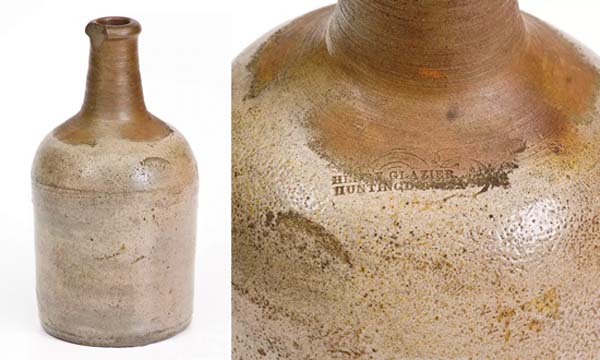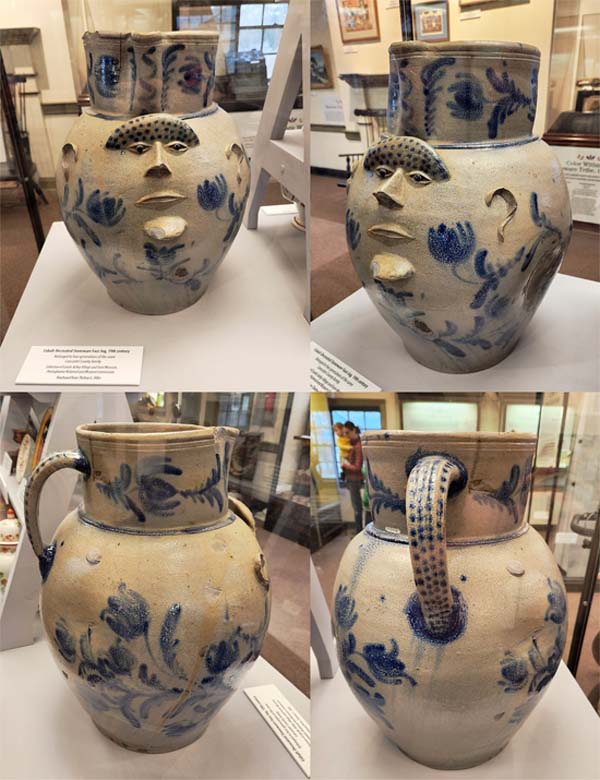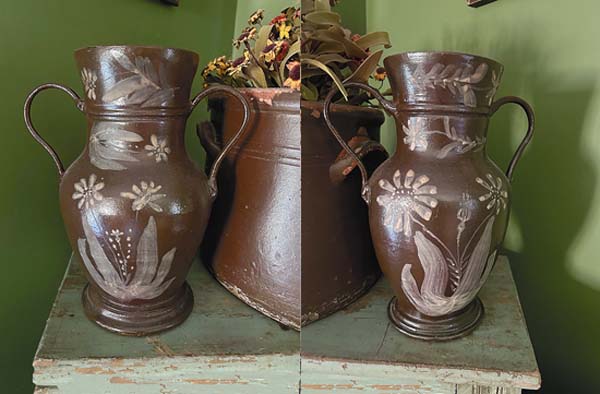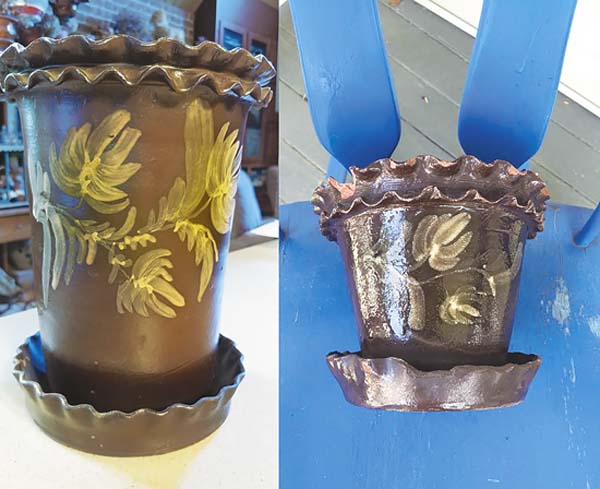A Century Of Red Earthenware And Stoneware Production In Huntingdon County, Pa., Ca. 1811-1912
By Justin W. Thomas - December 06, 2024
Located in central Pennsylvania, Huntingdon County was formed in 1787 and named for the evangelist and English Methodist leader,Selina Hastings, Countess of Huntingdon (1707-1791). Unlike other parts of the state, especially southeastern Pennsylvania, as well as Philadelphia, there is no known surviving 18th-century pottery production from this region, although it is known that for about a century, there was red earthenware and stoneware manufactured with the Hissong or Hyssong family for about 65 years, where the shapes included jugs, crocks, pitchers, poultry fountains, water coolers, batter jugs, match safes, rabbit feeders, a variety of floral wares and pipe for the Bloomsburg, Cassville and Lewistown communities, among likely other forms. The earliest dated example of pottery known from this region is an early 19th century three-color slip decorated red earthenware jar, inscribed on the base, Jacob Wareham / Frankstown Township / Huntingdon County / 1811. There is also a 19th century red earthenware puzzle jug known that is inscribed on the base, J. Wareham / Potter 1825. These inscriptions may represent Jacob Wareham, who was born ca. 1785 inHuntingdon County, Pa., to John (1752-1808) and Christeena Wareham (1752-1818). It was probably about 1798 when Jacob moved to Frankstown Township, seeing that his parents are listed as residents there based on the U.S. Direct Tax Lists from that year, and Jacob is also listed as living there in the 1810 United States Federal Census. However, there is very little published information that explains where Wareham learned the potters craft, although his father was born in Armstrong County, Pa., in 1752, while his mother was born in Baltimore, Md., also in 1752. However, the regions earliest stoneware production was likely the work of John and his son, Henry Glazier (1806-88), in Cassville, Pa., who operated a pottery business in Huntingdon County from about 1831-54. John was one of the towns early potters, manufacturing red earthenware, and he may have also employed the potter Matthias Ridenour. Additionally, Crocker Farm in Sparks, Md., has noted that Henry Glazier likely learned to make and decorate stoneware in Baltimore in the late 1820s. Glaziers wife, Elizabeth Bailey Glazier (1809-84), was born in Baltimore, Md., in 1809. Among the unusual decorations applied by Henry Glazier was the use of manganese, which when fired in the kiln produced a brown color. He also produced wares adorned with cobalt, where some of the decorations include floral motifs applied on such forms as pitchers and crocks that are similarly shaped to some objects produced by the Remmey family in both Baltimore and Philadelphia. it was likely the Baltimore and Philadelphia stoneware influence with Glazier that eventually impacted Elisha B. Hissong(1827-1901), who was born in Franklin County, Pa., in 1827, and began his career as an apprentice for four years in Waynesboro, Pa., before marrying Rachael Green Hyssong (1830-1919), a native of Cassville, and establishing a multi-generational pottery in Cassville in 1847. The most significant examples of Hissongs early production include a large ca. 1850 cobalt floral decorated stoneware face pitcher in the collection of the Landis Valley Village & Farm Museum in Lancaster, Pa. A related two-sided face pitcher with a cobalt floral decoration and two pouring spouts was consigned to Crocker Farm in 2017 (did not meet reserve), where its manufacture was described as, Possible Baltimore connections through Henry Glazier, Hissongs tenure in Waynesboro, or itinerant potters traveling north, could explain this pitchers Remmey-type face. Similarly, potters traveling westward from Philadelphia may also have been this pieces inspiration. Hissong also used a circular stamp during this early period, which reads, E.B. HISSONG / CASSVILL. According to a book published in 1915, titled Historical and Biographical Annals ofColumbia and Montour Counties Pennsylvania Containing A Concise History of the Two Counties and a Genealogical and Biographical Record of Representative Families, When Elisha B. Hyssongbuilt a pottery of his own (in Cassville) he had to clear the location, and that plant was carried on by the Hyssong family for nearly sixty-five years. The 1870 United States Federal Census identified a few family members who apprenticed under Elisha; those members included his sons, Austin L. Hyssong (1851-1922) and George L. Hyssong (1854-1922). Another son, Charles Bruce Hyssong (1868-1945), also became a potter, although he was only 2 years old at the time of the census; a fourth son, Russell Hyssong (1875-1932) also became a potter, but he is listed with a different occupation, beginning with the 1900 Federal Census. Interestingly, an 1873 map of Cassville shows the pottery business in the possession of Elishas wife, Rachael. Austin and George continued working at the pottery business for part of the 1870s, although in 1876, Austin married Anna Margaret Dipple Hyssong (1856-1943), daughter of John (1820-72) and Anna Margretta Peters Dipple (1833-1901), originally of Landkreis Kassel, Hessen, Germany. John was a potter by trade, and the family had settled in Lewistown, Pa., where John operated a pottery until his death in 1872 (Mifflin County). He was killed while crossing the tracks of the Pennsylvania Railroad, while on his way to dig clay. His wife, who survived until 1901, ran the business that he established for several years after his death, and she received help from her son-in-law, as well as her sons, John (1854-1906) and Curt Dipple (1860-1952). It was also published in the 1915 book, Historical and Biographical Annals ofColumbia and Montour Counties Pennsylvania, Austin L. Hyssong has carried on a pottery business at Bloomsburg (Pennsylvania) for over twenty years, during which time he has had to enlarge his original plant to accommodate the profitable trade he has built up in stoneware, stovepipe, collars, flowerpots and similar goods. This company also turned into a family enterprise, operating during the ca. 1891 to 1914 period. Furthermore, it was about 1890 that Charles (who also went by Bruce) was now operating the Cassville company with his brother Russell, where Bruce supervised the business until it closed in the spring of 1912. He then went to work as a potter at a crucible factory in Philadelphia. Interestingly, among the unusual types of pottery produced by the Hyssongs in Cassville in the late 19th century (and perhaps the early 20th century) is the use of a brown glaze with slip decoration, whereas the slip was often applied in floral motifs and sometimes appeared white in color and in other instances yellow. A number of the objects decorated with this style are flowerpots, but other forms include vases, lidded jars, crocks and batter pails. This is a significant style of production for central Pennsylvania during this period, which not only embraced the late 1800s need for utilitarian and florist ware, but the pottery also took an artistic approach, where some of the slip decoration techniques embraced styles manufactured in Pennsylvania in the 18th and 19th century. The most notable of the slip decorations is a tulip, which is an iconic motif of Pennsylvania-German decorative arts. Sources Lytle, Milton Scott. History of Huntingdon County in the State of Pennsylvania, From the Earliest Times to the Centennial Anniversary of American Independence, July 4, 1876. Lancaster, PA.: William H. Roy, Publisher, 1876. Historical and Biographical Annals ofColumbia and Montour Counties Pennsylvania Containing A Concise History of the Two Counties and a Genealogical and Biographical Record of Representative Families. Chicago: J. H. Beers & Co., 1915. Schaltenbrand, Phil. Big Ware Turners: The History and Manufacture of Pennsylvania Stoneware. Bentleyville, PA: Westerwald Press, 2002. Zipp, Mark. Stoneware In The Eastern United States. Bottles and Extras, March-April 2008.
















SHARE
PRINT